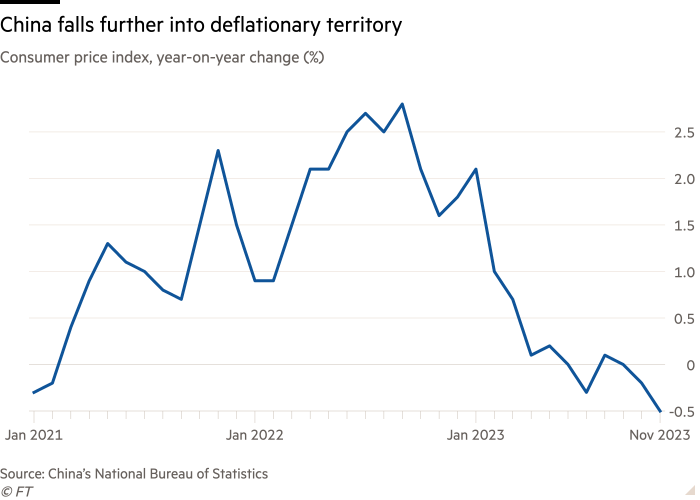Stay informed with free updates
Simply sign up Chinese economy myFT Digest – delivered straight to your inbox.
China’s consumer prices fell 0.5 percent year-on-year in November, the biggest drop in three years, as the world’s second-largest economy suffers deepening deflation.
Consumer prices fell more than the 0.2 percent expected by a Bloomberg survey of economists and exceeded October’s 0.2 percent decline.
Producer prices, which are measured at factory doors and are heavily influenced by the cost of goods and raw materials, fell by 3 percent and remained in negative territory over the past year.
Consumer prices entered deflationary territory in July, rising briefly in August before falling again in October. The deflationary trend adds to a host of economic pressures facing the country’s policymakers, including a liquidity crunch in the real estate sector, weak trade data, and a slowing recovery from three years of zero lockdowns and border closures.
Consumer demand is struggling to fully recover in 2023, while policymakers have set an economic growth target of just 5 percent, the lowest rate in decades.

Beijing has faced calls to step up stimulus this year in light of a prolonged real estate slowdown after several developers defaulted. The government cut key lending rates and issued new bonds to support growth but stopped short of implementing any major bailouts for developers.
Chinese leader Xi Jinping warned this week that the country’s economic recovery was still at a “critical stage” as officials pledged to increase fiscal and monetary support.
Rating agency Moody’s Investors Service on Tuesday lowered its outlook on China’s sovereign credit rating to negative, citing rising risks of lower economic growth in the medium term and an increased likelihood of greater fiscal support for vulnerable regions.
China’s economic momentum has been hurt in recent months by the default of Country Garden, the country’s largest private developer by sales, as well as turmoil at investment firm Zhongqi, a sign of the knock-on effects of a turbulent property market.
Policymakers in August stopped publishing youth unemployment data after the measure reached a record high since they began reporting it in 2019.
Consumer prices this year were affected by lower prices for pork, an important component of the basket of goods in the Chinese consumer index. Food prices fell by 4.2 percent in November.
The prolonged weakness in consumer prices contrasts with inflation in other major economies after they lifted anti-coronavirus measures, and points to weak demand from households in the face of continued caution in their spending. Data this week showed imports fell by 0.6 percent last month.
Next week’s data will indicate the pace of retail sales growth in November. In October, they rose 7.6 per cent, supported by a lower base effect compared to the previous year, when coronavirus lockdowns intensified before being abruptly abandoned at the end of the year.

“Beer aficionado. Gamer. Alcohol fanatic. Evil food trailblazer. Avid bacon maven.”
